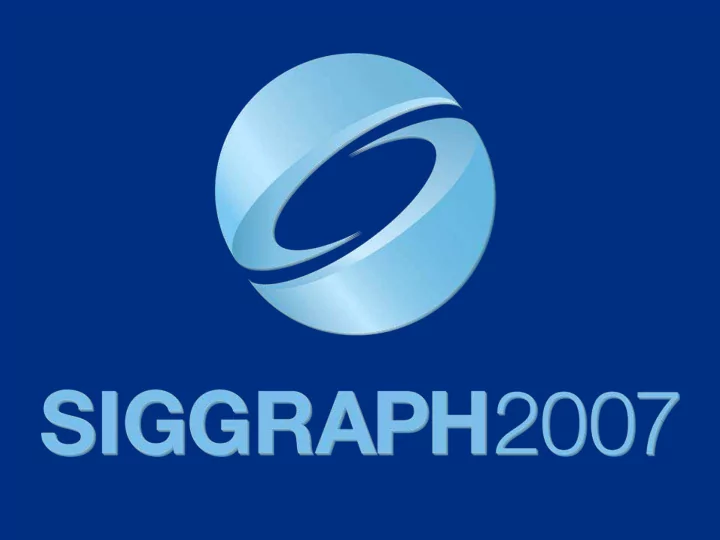

A Gentle Introduction A Gentle Introduction to Bilateral Filtering to Bilateral Filtering and its Applications and its Applications 08/10: Applications: Advanced uses of Bilateral Filters Jack Tumblin – EECS, Northwestern University
Advanced Uses of Bilateral Filters Advanced Uses of Bilateral Filters
Advanced Uses for Bilateral Advanced Uses for Bilateral A few clever, exemplary applications… • Flash/No Flash Image Merge (Petschnigg2004,Eisenman2004) • Tone Management (Bae 2006) • Exposure Correction (Bennett2006) (See also: Bennett 2007 Multispectral Bilateral Video Fusion, IEEE Trans. On Img Proc) Many more, many new ones… – 6 new SIGGRAPH 2007 papers!
Flash / No-Flash Photo Improvement Flash / No-Flash Photo Improvement (Petschnigg04) (Eisemann04) (Petschnigg04) (Eisemann04) Merge best features: warm, cozy candle light (no-flash) low-noise, detailed flash image
‘Joint Bilateral’ or ‘Cross Bilateral’ (2004) ‘Joint Bilateral’ or ‘Cross Bilateral’ (2004) Bilateral � two kinds of weights, Cross Bilateral Filter (CBF): � get them from two kinds of images. • Spatial smoothing of pixels in image A, with • WEIGHTED by intensity similarities in image B:
‘Cross’ or ‘Joint’ Bilateral Idea: ‘Cross’ or ‘Joint’ Bilateral Idea: Noisy but Strong… Range filter preserves signal Range filter preserves signal Use stronger signal’ ’s range s range Use stronger signal Noisy and Weak… filter weights… … filter weights
‘Joint’ or ‘Cross’ Bilateral Filter (CBF) ‘Joint’ or ‘Cross’ Bilateral Filter (CBF) • Enhanced ability to find weak details in noise (B’s weights preserve similar edges in A) • Useful Residues for ‘Detail Transfer’ – CBF(A,B) to remove A’s noisy details – CBF(B,A) to remove B’s less-noisy details; – add to CBF(A,B) for clean, detailed, sharp image (See the papers for details)
‘Joint’ or ‘Cross’ Bilateral Filter (CBF) ‘Joint’ or ‘Cross’ Bilateral Filter (CBF) • Enhanced ability to find weak details in noise (B’s weights preserve similar edges in A)
Overview Overview Basic approach of both flash/noflash papers Remove noise + details from image A, Keep as image A Lighting No-flash ----------------------- Obtain noise-free details from image B, Result Discard Image B Lighting
Petschnigg: Detail Transfer Results Petschnigg: Detail Transfer Results • Lamp made of hay: Detail Transfer Flash No Flash
Petschnigg: Petschnigg: • Flash
Petschnigg: Petschnigg: • No Flash,
Petschnigg: Petschnigg: • Result
Approaches - - Main Idea Main Idea Approaches
Petschnigg04, Eisemann04 Features Petschnigg04, Eisemann04 Features Eisemann 2004: 2004: Eisemann --included image registration, included image registration, -- --used lower used lower- -noise flash image for color, and noise flash image for color, and -- --compensates for flash shadows compensates for flash shadows -- Petschnigg 2004: 2004: Petschnigg --included explicit color included explicit color- -balance & red balance & red- -eye eye -- --interpolated interpolated ‘ ‘continuously variable continuously variable’ ’ flash, flash, -- --Compensates for flash Compensates for flash specularities specularities --
Tonal Management Tonal Management (Bae et al., SIGGRAPH 2006) (Bae et al., SIGGRAPH 2006) Cross bilateral, residues � visually compelling image decompositions. • Explore: adjust component contrast, find visually pleasing transfer functions, etc. • Stylize: finds transfer functions that match histograms of preferred artists, • ‘Textureness’; local measure of textural richness; can use this to guide local mods to match artist’s
Tone Mgmt. Tone Mgmt. Examples: Examples: Original
Tone Mgmt. Tone Mgmt. Examples: Examples: ‘Bright and Sharp’
Tone Mgmt. Tone Mgmt. Examples: Examples: detailed Gray and
Tone Mgmt. Tone Mgmt. Smooth and Examples: Examples: grainy
Tone Management Examples Tone Management Examples Source
Tone Management (Bae06) Tone Management (Bae06) ‘Textured -ness’ Metric: (shows highest Contrast- adjusted texture)
Reference Model Reference Model Model: Ansel Adams
Results Results Input with auto-levels
Results Results • Direct Histogram Transfer (dull)
Results Results • Best…
Video Enhancement Using Video Enhancement Using Per Pixel Exposures (Bennett, 06) Per Pixel Exposures (Bennett, 06) From this video: ASTA: A daptive S patio- S T emporal T A ccumulation Filter
VIDEO VIDEO
The Process for One Frame The Process for One Frame • Raw Video Frame: (from FIFO center) • Histogram stretching; (estimate gain for each pixel) • ‘Mostly Temporal’ Bilateral Filter: – Average recent similar values, – Reject outliers (avoids ‘ghosting’), spatial avg as needed – Tone Mapping
The Process for One Frame The Process for One Frame • Raw Video Frame: (from FIFO center) • Histogram stretching; (estimate gain for each pixel) • ‘Mostly Temporal’ Bilateral Filter: – Average recent similar values, – Reject outliers (avoids ‘ghosting’), spatial avg as needed – Tone Mapping
The Process for One Frame The Process for One Frame • Raw Video Frame: (from FIFO center) • Histogram stretching; (estimate gain for each pixel) • ‘Mostly Temporal’ Bilateral Filter: (color: # avg’ pixels) – Average recent similar values, – Reject outliers (avoids ‘ghosting’), spatial avg as needed – Tone Mapping
The Process for One Frame The Process for One Frame • Raw Video Frame: (from FIFO center) • Histogram stretching; (estimate gain for each pixel) • ‘Mostly Temporal’ Bilateral Filter: – Average recent similar values, – Reject outliers (avoids ‘ghosting’), spatial avg as needed – Tone Mapping
Bilateral Filter Variant: Mostly Temporal Bilateral Filter Variant: Mostly Temporal • FIFO for Histogram-stretched video – Carry gain estimate for each pixel; – Use future as well as previous values; • Expanded Bilateral Filter Methods: – Static scene? Temporal-only avg. works well – Motion? Bilateral rejects outliers: no ghosts! • Generalize: ‘Dissimilarity’ (not just || I p – I q || 2 ) • Voting: spatial filter de-noises motion
Multispectral Bilateral Video Fusion Multispectral Bilateral Video Fusion (Bennett,07) (Bennett,07) • Result: – Produces watchable result from unwatchable input – VERY – VERY robust; accepts almost any dark video; – Exploits temporal coherence to emulate Low-light HDR video, without special equipment
Conclusions Conclusions • Bilateral Filter easily adapted, customized to broad class of problems • One tool among many for complex problems • Useful in for any task that needs Robust, reliable smoothing with outlier rejection
Recommend
More recommend